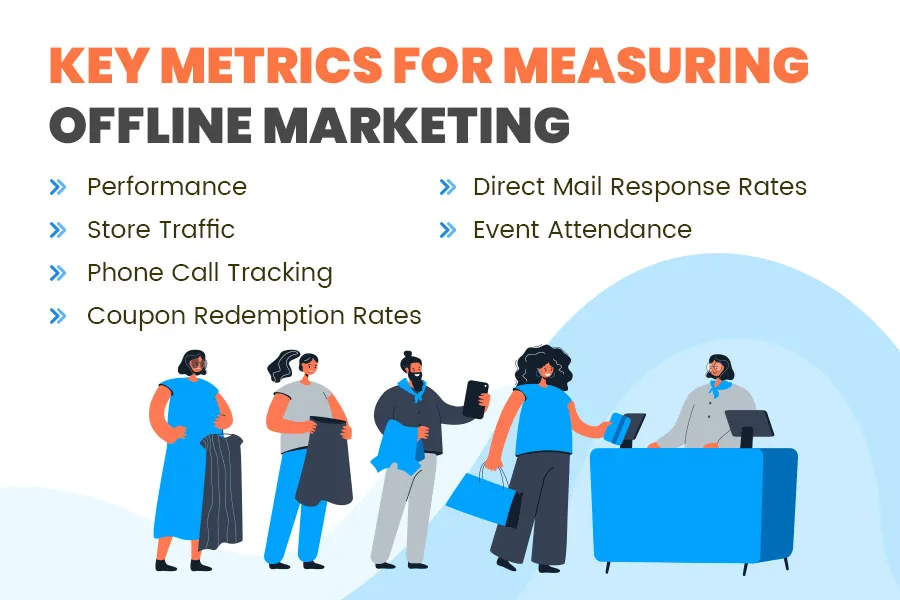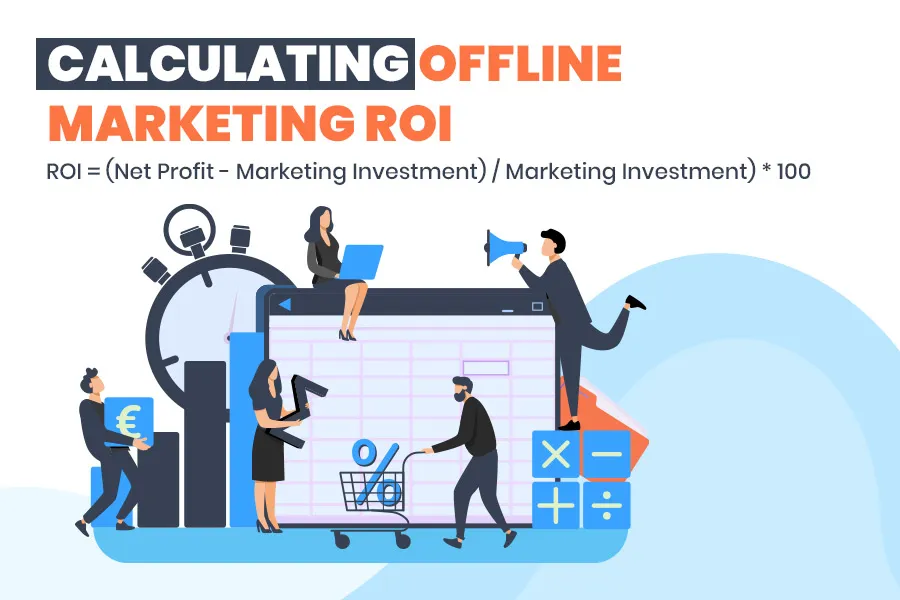Introduction
You have recently launched a new product line and are eager to promote it to a wider audience. You decide to use a mix of offline marketing and online marketing channels to reach your target audience. You create an awe-inspiring brand message and an exceptional logo design for your product, which you print on posters, flyers, and billboards.
In addition, you have sponsored a few local events, distributing free samples and coupons to potential customers. You've also employed online advertising, social media marketing, and newsletters or email marketing to complement your offline marketing efforts.
Your zeal for this marketing campaign is high, and you anticipate a significant increase in sales and brand recognition. How can you determine the success of your campaign? How can you measure your offline marketing initiatives' return on investment? How do you track the customer journey from viewing your billboard to purchasing your product? Furthermore, how can you compare the effectiveness of offline marketing and online marketing channels?
Indeed, these are common challenges faced by many marketers when it comes to measuring offline marketing initiatives. Measuring offline marketing is not as easy as online marketing, where you can use analytics tools to track every click, impression, and conversion.
Offline marketing requires creativity and innovation to capture and analyze data and attribute conversions. However, this does not mean offline marketing is less important or valuable than online marketing. Offline marketing can have a powerful impact on consumer behavior and brand recognition, especially when combined with online marketing.
In this blog post, we'll show you how to measure offline marketing performance and unlock the ROI of your campaigns. We'll explore the tools and techniques available for tracking and attributing offline conversions and best practices for integrating offline and online data.
By the end, you will clearly understand how to optimize your offline marketing strategy and effectively demonstrate its value to your business.
Are you ready to learn more? Let's get started!
Understanding Offline Marketing
Offline marketing refers to promotional activities conducted outside the digital realm. These include traditional channels such as print advertisements, television and radio commercials, billboards, direct mail, event sponsorships, and more.
Despite the rise of online marketing, offline marketing still holds significant value, particularly for businesses targeting local audiences or seeking to create a tangible connection with customers. Offline marketing allows face-to-face interactions, sensory experiences, and increased brand recognition.
Offline marketing has its unique benefits and limitations. Unlike online marketing, offline marketing enables businesses to engage directly with customers in physical spaces, creating personal connections and building trust.
It also allows for greater brand visibility, as many potential customers can see billboards, signage, and print materials. Additionally, offline marketing can target specific geographic areas, making it ideal for local businesses.
However, offline marketing can be more challenging to measure and track than online marketing. Determining the direct impact of offline marketing efforts on customer behavior and sales conversions requires implementing effective measurement strategies.
Related Blog: How to Create a Brand Strategy Plan
Tips to Measure Offline Marketing ROI
Establishing Clear Objectives
Defining the ROI of your offline marketing efforts is crucial. What do you hope to achieve with your offline campaigns? Are you looking to increase brand awareness, drive foot traffic to your store, or generate phone inquiries? Defining specific and measurable goals creates a foundation for evaluating success.
When setting objectives, consider SMART goals: Specific, Measurable, Attainable, Relevant, and Time-bound. For example, a specific purpose could be to increase in-store foot traffic by 20% within three months. This objective is measurable, achievable, relevant to your business, and has a specific timeframe for evaluation.
Unique URLs and Custom Landing Pages
Offline marketing often drives potential customers to your website. To track the effectiveness of these efforts, consider using unique URLs or custom landing pages in your offline materials.
By incorporating different web addresses in print ads, flyers, or direct mailers, you can attribute website traffic and conversions specifically to your offline campaigns.
Pro Tip: Consider implementing a strategic approach to measure the impact of your offline marketing campaign effectively.
For example, if you're running a domain ad campaign in a local magazine, you can create an attractive landing page with a unique URL, such as www.jaymehta.co, and prominently feature this URL in your advertisement.
By implementing this approach, you can meticulously track and analyze the traffic and conversions exclusively attributed to this dedicated landing page. This valuable data will enable you to gauge the success of your offline marketing efforts, provide you with actionable insights for future campaigns and help you optimize your overall marketing strategy.
Related Blog: Why Having a Domain Name is Important
QR Codes and Short URLs
QR (Quick Response) codes have become increasingly popular in bridging the offline and online marketing gap. When scanned by a smartphone, these codes direct users to a specific webpage or online resource.
By including QR codes in your offline materials, you can track the number of scans and conversions, providing valuable insights into the performance of your offline campaigns.
Similarly, short URLs in offline materials can facilitate tracking and provide valuable data on user engagement. Short URLs are memorable web addresses that redirect to longer URLs.
You can track the traffic and conversions associated with each channel by creating unique short URLs for offline marketing channels, such as www.hostitsmart.com or www.viralpep.com
Coupon Codes and Discount Offers
One effective way to measure the success of your offline marketing efforts is by incorporating unique coupon codes or discount offers. By assigning a specific code to each campaign, you can track the number of redemptions and attribute them to your offline promotions.
This method not only helps measure ROI but also encourages customer engagement and provides an incentive for potential buyers.
For example, if you are running a radio advertising campaign, you can provide a special discount code that customers mention when purchasing. By monitoring the usage of that code, you can gauge the effectiveness of your offline marketing efforts.
Additionally, consider offering different codes for offline channels, such as print ads, radio, or outdoor billboards, to determine which channels generate the most response.
Call Tracking and Analytics
Phone inquiries are a common outcome of successful offline marketing campaigns. To measure the impact of your offline efforts on phone calls, consider implementing call tracking systems.
These systems assign unique phone numbers to different campaigns and track incoming calls, providing valuable insights into the effectiveness of your offline marketing channels.
Integrating call tracking with analytics tools allows you to analyze call duration, conversion rates, and caller demographics, further refining your understanding of offline marketing performance.
By using call tracking, you can attribute incoming calls to specific offline marketing campaigns and assess their contribution to your overall ROI. Call tracking also enables you to evaluate the quality of leads generated through offline channels, helping you optimize your marketing strategies accordingly.
Read also: Diversifying Your Marketing Strategies
-
Surveys and Feedback Forms
While traditional methods like surveys and feedback forms may seem old-fashioned, they remain powerful tools for measuring offline marketing effectiveness. You can gather valuable customer feedback by distributing surveys at the point of sale or through direct mail.
Questions regarding how they discovered your business or what motivated them to make a purchase can offer valuable insights into the impact of your offline marketing efforts.
Consider including survey links or QR codes in your offline materials, allowing customers to provide feedback online. This approach simplifies data collection and lets you analyze responses digitally, saving time and effort.
Ensure that the survey questions are tailored to gather information relevant to your offline marketing objectives, such as the effectiveness of specific advertising channels or customer satisfaction with promotions.
-
Geo-Targeted Advertising and Proximity Tracking
Geo-targeted advertising allows you to deliver customized ads to specific geographic regions. By employing this approach, you can track the effectiveness of your offline marketing in particular locations.
Additionally, proximity tracking technologies, such as beacon technology, enable you to measure foot traffic and customer behavior within physical sites. These methods provide valuable data on the offline impact of your marketing campaigns and can help refine future strategies.
Geo-targeted advertising relies on location-based data to deliver relevant ads to consumers in specific areas. By monitoring the response rates, click-through rates, and conversions of these targeted ads, you can assess the effectiveness of your offline marketing campaigns in different regions.
On the other hand, proximity tracking technologies use devices like beacons to detect and interact with customers in physical locations, allowing you to measure foot traffic and analyze customer behavior patterns.
Why Measure Offline Marketing ROI?
Measuring offline marketing performance is essential for several reasons. First and foremost, it provides insights into the effectiveness of your marketing efforts. You can optimize your marketing budget and resource allocation by understanding which offline channels and campaigns yield the best results.
Moreover, measuring ROI helps justify marketing expenses to stakeholders and demonstrates the value generated by offline initiatives. Finally, it lets you align your offline marketing strategies with overall business goals, ensuring your efforts drive tangible outcomes.
Read also: How retailers invest their budget in marketing strategies
Key Metrics for Measuring Offline Marketing Performance

When measuring offline marketing performance, identifying the right metrics is crucial. Here are some key metrics to consider:
Store Traffic
Tracking the number of visitors to your physical store or location can provide valuable insights into the effectiveness of offline campaigns. By comparing foot traffic during and after specific offline marketing initiatives, you can assess their impact on generating customer interest and driving store visits.
Phone Call Tracking
Assigning unique phone numbers to offline marketing initiatives allows you to measure call volume and attribute conversions to specific campaigns. By tracking incoming calls and their quality, you can assess the success of offline advertisements and promotions that include contact phone numbers.
Coupon Redemption Rates
Monitoring the number of coupons redeemed in-store indicates offline marketing efforts' impact on consumer behavior. By analyzing coupon redemption rates and comparing them to the distribution of coupons, you can evaluate the effectiveness of coupon-based campaigns in driving sales and customer engagement.
Direct Mail Response Rates
Tracking the response rates of direct mail campaigns helps measure their effectiveness and guides future targeting and messaging strategies. By analyzing response rates, including the number of inquiries or actions taken from direct mail, you can determine the success of specific mail campaigns and make adjustments to optimize their impact.
Event Attendance
Evaluating the number of attendees and their engagement levels at sponsored events or trade shows helps gauge the success of offline marketing initiatives. By tracking event attendance and measuring attendee interactions or conversions, you can assess the effectiveness of offline event-based marketing efforts in generating leads or sales.
Implementing Measurement Strategies
Implementing specific measurement strategies to measure offline marketing performance effectively is important. Here are some key steps to follow:
-
Set Clear Objectives
Clearly define the goals and objectives of your offline marketing campaigns to align them with measurable outcomes. For example, if you aim to increase store traffic, determine the desired increase in footfall and the timeframe within which you expect to achieve it.
Establish Tracking Mechanisms
Utilize unique URLs, landing pages, or dedicated phone numbers to track different campaigns' response and engagement levels. For example, create unique landing pages for specific offline campaigns and use analytics tools to monitor traffic and conversion rates associated with those pages.
QR Codes and Coupon Codes
Incorporate QR codes or unique coupon codes in your offline materials to track their usage and redemption rates. You can easily measure and analyze each campaign's response rates and conversions by assigning unique codes to different campaigns.
Customized Phone Numbers
Assign specific phone numbers to offline marketing initiatives, enabling you to track call volumes and conversions. This allows you to identify which campaigns drive phone inquiries and which are the most effective in generating leads or sales.
Integrate Offline and Online Data
Combine offline and online data sources to gain a holistic view of your marketing efforts and their impact on overall performance.
By integrating data from offline channels, such as store visits or phone calls, with online data, such as website analytics or online sales, you can better understand the customer journey and the overall effectiveness of your marketing campaigns.
Calculating Offline Marketing ROI

Calculating ROI is crucial to understanding the profitability and success of your offline marketing campaigns. Here's a formula to help you calculate ROI:
ROI = (Net Profit - Marketing Investment) / Marketing Investment * 100
To determine net profit, subtract the total cost of goods sold and operating expenses from the total revenue generated by your offline campaigns. You can express ROI as a percentage by dividing the result by the marketing investment and multiplying it by 100.
Analyzing and interpreting ROI results is equally important. A positive ROI indicates that your offline marketing efforts generate profit, while a negative ROI suggests optimizing or reassessing your strategies. By evaluating the ROI of different campaigns or channels, you can make data-driven decisions to allocate resources effectively and optimize your marketing efforts.
Tools & Technologies for Offline Marketing Measurement
Several tools and technologies can assist in measuring offline marketing performance. Here are a few worth considering:
CRM Systems and Customer Tracking
Implementing a customer relationship management (CRM) system allows you to track customer interactions and connect them to specific offline marketing initiatives.
By integrating offline customer data, such as in-store purchases or event attendance, with online customer data, you can gain valuable insights into customer behavior and preferences.
Related Blog: The Ultimate Guide to CRM for Your Businesses Success
Analytics Platforms for Offline Marketing
Utilize analytics platforms that provide robust reporting and analysis capabilities tailored to offline marketing metrics. These platforms can help you monitor and measure offline marketing KPIs, visualize data trends, and generate reports to inform your marketing decisions.
Advanced Technologies
Explore emerging technologies such as beacons or Radio Frequency Identification (RFID) to collect data and gain deeper insights into customer behavior and engagement.
Beacons placed in physical stores can track customer movement and interactions, providing valuable data on foot traffic patterns and customer preferences.
The Benefits & Challenges Of Offline Marketing Measurement
Let's explore the benefits and challenges of best practices for integrating offline and online data and learn how to achieve successful integration.
Pros:
Holistic View
Integrating offline and online data gives businesses a holistic view of their marketing performance. By combining data from various sources, including both digital and traditional channels, marketers can assess the overall impact of their marketing efforts more accurately.
Attribution Accuracy
One significant advantage of integrating offline and online data is accurately attributing conversions and sales. By linking offline activities with online interactions, marketers can trace customer journeys across channels and determine which marketing touchpoints contribute most to conversions.
This attribution accuracy helps businesses gain a clearer understanding of the ROI associated with their offline marketing campaigns.
Optimization Opportunities
Integrated data insights allow businesses to identify the most effective offline marketing activities. By analyzing the combined data, marketers can pinpoint which channels, advertisements, or campaigns generate the highest engagement and conversion rates.
With this knowledge, companies can allocate resources more efficiently and optimize offline marketing efforts accordingly.
Customer Insights
Linking offline and online data gives businesses deeper insights into customer behavior, preferences, and engagement across various touchpoints. By understanding how customers interact with offline and online channels, marketers can tailor their messaging and campaigns to enhance the overall customer experience.
This comprehensive understanding of customers helps businesses refine their targeting strategies and personalize their marketing approaches.
Cons:
Data Complexity
Integrating offline and online data can be technically complex. Data formats, systems, and platforms differ between offline and online channels, making integration challenging.
It often requires substantial resources and expertise to ensure accurate data matching and synchronization, overcoming discrepancies that arise from different data sources.
Privacy Concerns
Integrating offline and online data necessitates handling personally identifiable information (PII), raising privacy concerns. Businesses must comply with relevant data protection regulations and implement robust security measures to safeguard customer data during integration.
Adhering to privacy laws and adopting stringent data protection practices is crucial to maintaining customer trust and ensuring compliance.
Data Accuracy Limitations
Offline data collection methods, like surveys or customer interviews, may introduce biases or inaccuracies. These limitations can affect the accuracy and reliability of the integrated data. It is essential to account for potential biases and limitations when analyzing the integrated data and interpreting the results.
Attribution Complexity
Assigning conversions or sales to specific marketing channels can be challenging, especially when customers interact with offline and online touchpoints. Determining the exact contribution of each channel to conversion may require sophisticated attribution models that consider multiple variables.
Achieving accurate attribution is a complex task, and marketers need to carefully evaluate and select appropriate attribution models for their specific business needs.
Best Practices for Integrating Offline and Online Data
Integrating offline and online data is a vital step in measuring offline marketing performance and unlocking the ROI of your campaigns. Combining data from different sources and channels gives you a comprehensive view of your customer's journey and behavior, allowing you to optimize your marketing strategy accordingly.
Still, integrating offline and online data is not straightforward. It demands careful planning, execution, and evaluation. Here are some best practices for integrating offline and online data:
Define your Goals & KPIs.
Clearly define your goals and metrics for measuring offline marketing performance. Align these objectives with your overall business goals and identify the key performance indicators (KPIs) that will help you evaluate the success of your offline marketing campaigns.
Unified Tracking Systems
Implement a unified tracking system that captures data from both offline and online sources. This may involve using unique identifiers like phone numbers or QR codes to link offline activities with online interactions. By integrating tracking mechanisms, businesses can comprehensively view customer interactions across channels.
Data Standardization
Ensure consistency in data formats, naming conventions, and data structures across offline and online datasets. This standardization facilitates seamless integration and accurate analysis of the combined data.
By adopting standardized data practices, businesses can eliminate data inconsistencies and improve the quality of their analysis.
Robust Analytics Platforms
Utilize advanced analytics platforms that can handle offline and online data. These platforms should provide comprehensive reporting, visualization, and attribution capabilities. With such tools, businesses can analyze integrated data effectively, visualize trends, and gain actionable insights to drive marketing strategies.
Customer Surveys and Feedback
Supplement your data integration efforts by collecting customer surveys or feedback to obtain qualitative insights. While integrating quantitative data is crucial, qualitative data obtained from surveys can provide valuable context and validate the findings derived from the integrated data.
Combining quantitative and qualitative insights enables a more comprehensive understanding of your customers' experiences.
Test and Optimize
Continuously test and refine your integration methods to enhance data accuracy and uncover valuable insights. Experiment with different attribution models and techniques to identify the most effective approach for your business.
Regularly analyze and interpret the integrated data, making data-driven adjustments to optimize your marketing efforts.
Privacy and Compliance
Prioritize data privacy and compliance throughout the integration process. Adhere to relevant data protection regulations, such as the General Data Protection Regulation (GDPR), and implement robust security measures to safeguard customer data.
Obtain necessary consent for data collection and ensure safe data handling practices to build customer trust.
By implementing these best practices, businesses can overcome the challenges of integrating offline and online data. They can unlock valuable insights to accurately measure the performance and ROI of their offline marketing efforts.
With a comprehensive understanding of their marketing campaigns, businesses can make informed decisions, optimize their marketing strategies, and drive better results.
Read also: Top Digital Marketing Trends for 2025 by Jay Mehta
Case Studies and Examples
Examining real-world examples of successful offline marketing measurement can provide valuable insights and inspiration. Explore case studies from various industries and campaign types to understand how organizations have effectively measured and optimized their offline marketing performance.
Analyze their strategies, the metrics they prioritized, and the lessons learned from their experiences. Case studies can serve as practical guides to implementing measurement strategies and identifying best practices.
Future Trends in Offline Marketing Measurement
The field of offline marketing measurement is continually evolving. Stay ahead by exploring future trends and emerging technologies that can enhance your measurement capabilities. Predictive analytics and machine learning algorithms can help forecast the impact of offline marketing campaigns.
In contrast, integrating offline and online marketing measurement provides a more comprehensive understanding of customer journeys and overall marketing performance. Stay updated on industry advancements and technological innovations to optimize your offline marketing measurement efforts.
Read Also: The Power of AI in Digital Marketing: Strategies for Success
Final Thoughts
Unlock the true potential of your offline marketing campaigns and drive tangible results for your business by measuring their performance effectively.
Understanding the impact of your offline marketing efforts and utilizing the right metrics, tracking mechanisms, and tools allow you to optimize your strategies, allocate resources efficiently, and achieve tangible business outcomes.
Stay ahead of the curve by staying informed about technological advancements and emerging measurement approaches, adapting to future trends, and maximizing the impact of your offline marketing efforts in today's digital age. Embrace the power of data-driven decisions and strive for marketing excellence by actively measuring the performance of your offline marketing.
While online marketing has transformed performance measurement, offline marketing remains a potent business tool. Implement the strategies mentioned above to effectively measure the ROI of your offline marketing efforts, gain valuable insights, and optimize your marketing strategies accordingly.
Set clear objectives, leverage unique URLs and landing pages, QR codes, and short URLs, incorporate coupon codes, implement call tracking and analytics, gather customer feedback through surveys, and explore geo-targeted advertising and proximity tracking.
Harness the power of creativity, meticulous data analysis, and innovative measurement techniques to unlock the untapped potential of your offline marketing campaigns, generating impactful outcomes that will drive significant growth for your business.
For more marketing insights and strategies, visit jaymehta.co, a trusted resource dedicated to helping businesses succeed in their marketing endeavors. Discover new ways to excel in your marketing efforts and unlock remarkable achievements.











